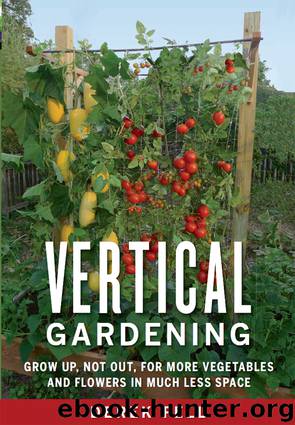Vertical Gardening by Derek Fell

Author:Derek Fell
Language: eng
Format: epub
Publisher: Rodale
Published: 2011-03-29T04:00:00+00:00
These three supports make it easy to grow a vegetable spaghetti squash vine: along chain-link fencing, on a fan-shaped trellis, and in the middle of a wire cylinder.
’Vegetable Spaghetti’ (80 days) grows a vigorous vine similar to that of ‘Trombone’ zucchini, but the fruits are shaped like an oblong melon, with either creamy white, yellow, or orange skin, depending on variety. Up to a dozen fruit is possible from a single plant. At maturity, the fruits have a hard shell like a winter squash and similarly can be stored in a cool, dark place for long periods. But the interior is like no other squash: Cooked, it fluffs up into long cream-colored strands just like pasta spaghetti, but without the calories. The strands will soak up the flavor of whatever sauce you want to serve on it, whether marinara sauce, clam sauce, or parsley butter. Some catalogs classify it as a winter squash, but since it matures in summer weeks ahead of winter squash, other seedsmen list it as a summer squash.
I rate vegetable spaghetti as one of the easiest vegetables to grow vertically from seed. And one of the most profitable, as well, since the fruits can weigh 5 pounds each. I have seen them on the produce counter at many supermarkets for $2.50 a pound. Since a 5-pound vegetable spaghetti will total $12.50 at the market, and a vine can produce a dozen fruits, that's a potential value of $150 per vine—all for about 15 cents per seed!
Vegetable spaghetti was discovered in China by the Sakata Seed Company (now headquartered in Yokohama, Japan), although all squash are believed to be from the Americas. No one can explain how the squash reached China, but when Mr. Sakata put it in his seed catalog in 1934, he called it spaghetti squash, and it did not sell. He believes it was difficult for seedsmen and their customers to imagine a squash tasting like spaghetti, so he removed it from commerce. But later, in 1960, he reintroduced it as vegetable spaghetti. That small change—calling it vegetable spaghetti instead of spaghetti squash—made all the difference, especially when he promoted it as a low-calorie substitute for spaghetti.
The vegetable spaghetti that Mr. Sakata introduced has a pale yellow skin and is still available. But since then, other plant breeders have introduced new varieties with an orange skin and even one with a yellow-and-orange mottled skin. The interior flesh is still a creamy white, irrespective of the skin color, and I still prefer the Sakata original for its impressive size and yield.
What few people realize is that vegetable spaghetti is a climbing vine, with tendrils that allow it to be self-supporting. It will grasp any kind of trellis, and it especially likes to climb a chain-link fence. In 1982, I collaborated with herbalist Phyllis Shaudys on a book titled The Vegetable Spaghetti Cookbook. I wrote the plant's growing instructions, and Phyllis tested 100 recipes. In the introduction to the book, she explained that her first experience with vegetable spaghetti was when she and her daughter Kim decided to lose weight.
Download
This site does not store any files on its server. We only index and link to content provided by other sites. Please contact the content providers to delete copyright contents if any and email us, we'll remove relevant links or contents immediately.
Turbulence by E. J. Noyes(7720)
The Thirst by Nesbo Jo(6452)
Gerald's Game by Stephen King(4386)
Be in a Treehouse by Pete Nelson(3654)
Marijuana Grower's Handbook by Ed Rosenthal(3520)
The Sprouting Book by Ann Wigmore(3423)
The Red Files by Lee Winter(3286)
The Remains of the Day by Kazuo Ishiguro(3148)
Sharp Objects: A Novel by Gillian Flynn(2852)
Christian (The Protectors Book 1) by L. Ann Marie(2607)
Organic Mushroom Farming and Mycoremediation by Tradd Cotter(2572)
The Culinary Herbal by Susan Belsinger(2342)
Stone Building by Kevin Gardner(2297)
Lilac Girls by Martha Hall Kelly(2205)
The Starter Garden Handbook by Alice Mary Alvrez(2203)
The Unlikely Pilgrimage of Harold Fry by Rachel Joyce(2140)
The Lean Farm Guide to Growing Vegetables: More In-Depth Lean Techniques for Efficient Organic Production by Ben Hartman(2014)
Urban Farming by Thomas Fox(1987)
Backyard Woodland by Josh VanBrakle(1837)
